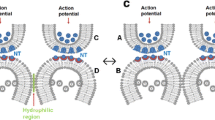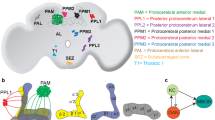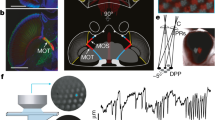Abstract
Visual cognition, as one of the fundamental aspects of cognitive neuroscience, is generally associated with high-order brain functions in animals and human. Drosophila, as a model organism, shares certain features of visual cognition in common with mammals at the genetic, molecular, cellular, and even higher behavioral levels. From learning and memory to decision making, Drosophila covers a broad spectrum of higher cognitive behaviors beyond what we had expected. Armed with powerful tools of genetic manipulation in Drosophila, an increasing number of studies have been conducted in order to elucidate the neural circuit mechanisms underlying these cognitive behaviors from a genes-brain-behavior perspective. The goal of this review is to integrate the most important studies on visual cognition in Drosophila carried out in mainland China during the last decade into a body of knowledge encompassing both the basic neural operations and circuitry of higher brain function in Drosophila. Here, we consider a series of the higher cognitive behaviors beyond learning and memory, such as visual pattern recognition, feature and context generalization, different feature memory traces, salience-based decision, attention-like behavior, and cross-modal leaning and memory. We discuss the possible general gain-gating mechanism implementing by dopamine — mushroom body circuit in fly’s visual cognition. We hope that our brief review on this aspect will inspire further study on visual cognition in flies, or even beyond.
Similar content being viewed by others
References
Liu L, Wolf R, Ernst R, et al. Context generalization in Drosophila visual learning requires the mushroom bodies. Nature, 1999, 400: 753–756, 10466722, 10.1038/22919, 1:CAS:528:DyaK1MXltFKns7o%3D
Tang S, Guo A. Choice behavior of Drosophila facing contradictory visual cues. Science, 2001, 294: 1543–1547, 11711680, 10.1126/science.1058237, 1:CAS:528:DC%2BD3MXosFKisbk%3D
Tang S, Wolf R, Xu S, et al. Visual pattern recognition in Drosophila is invariant for retinal position. Science, 2004, 305: 1020–1022, 15310908, 10.1126/science.1099839, 1:CAS:528:DC%2BD2cXmsVGmtrw%3D
Guo J, Guo A. Crossmodal interactions between olfactory and visual learning in Drosophila. Science, 2005, 309: 307–310, 16002621, 10.1126/science.1111280, 1:CAS:528:DC%2BD2MXlsl2jtLw%3D
Liu G, Seiler H, Wen A, et al. Distinct memory traces for two visual features in the Drosophila brain. Nature, 2006, 439: 551–556, 16452971, 10.1038/nature04381, 1:CAS:528:DC%2BD28XpsVCgsg%3D%3D
Peng Y, Xi W, Zhang W, et al. Experience improves feature extraction in Drosophila. J Neurosci, 2007, 27: 5139–5145, 17494699, 10.1523/JNEUROSCI.0472-07.2007, 1:CAS:528:DC%2BD2sXmtVWrsLo%3D
Zhang K, Guo J Z, Peng Y, et al. Dopamine-mushroom body circuit regulates saliency-based decision-making in Drosophila. Science, 2007, 316: 1901–1904, 17600217, 10.1126/science.1137357, 1:CAS:528:DC%2BD2sXmvV2mu7w%3D
Xi W, Peng Y, Guo J, et al. Mushroom bodies modulate salience-based selective fixation behavior in Drosophila. Eur J Neurosci, 2008, 27: 1441–1451, 18364023, 10.1111/j.1460-9568.2008.06114.x
Heisenberg M, Wolf R. Reafferent control of optomotor yaw torque in Drosophila melanogaster. J Comp Physiol A, 1988, 163: 373–388, 10.1007/BF00604013
Wolf R, Heisenberg M. Basic organization of operant behavior as revealed in Drosophila flight orientation. J Comp Physiol A, 1991, 169: 699–705, 1795235, 10.1007/BF00194898, 1:STN:280:DyaK387nslWqsw%3D%3D
Sutton R S, Barto A G. Reinforcement Learning: An Introduction. MA: MIT Press. 1998.
Skinner B F. The Behavior of Organisms: An Experimental Analysis. Oxford: Appleton-Century. 1938.
Götz K G. Optomotorische Untersuchung des visuellen Systems einiger Augenmutanten der Fruchtfliege Drosophila. Kybernetik, 1964, 2: 77–92, 5833196, 10.1007/BF00288561
Heisenberg M, Wolf R. Vision in Drosophila. In studies of brain function. Berlin: Springer. 1984. XII.
Guo A, Li L, Xia S Z, et al. Conditioned visual flight orientation in Drosophila: dependence on age, practice, and diet. Learn Mem, 1996, 3: 49–59, 10456076, 10.1101/lm.3.1.49, 1:STN:280:DyaK1MzosFSiug%3D%3D
Brembs B, Heisenberg M. Conditioning with compound stimuli in Drosophila melanogaster in the flight simulator. J Exp Biol, 2001, 204: 2849–2859, 11683440, 1:STN:280:DC%2BD3MngvVCjtw%3D%3D
Xia S, Liu L, Feng C, et al. Memory consolidation in Drosophila operant visual learning. Learn Mem, 1997, 4: 205–218, 10456064, 10.1101/lm.4.2.205, 1:STN:280:DyaK1MzosFSjtA%3D%3D
von der Malsburg C. Binding in models of perception and brain function. Curr Opin Neurobiol, 1995, 5: 520–526, 7488855, 10.1016/0959-4388(95)80014-X
Singer W, Gray C M. Visual feature integration and the temporal correlation hypothesis. Annu Rev Neurosci, 1995, 18: 555–586, 7605074, 10.1146/annurev.ne.18.030195.003011, 1:CAS:528:DyaK2MXktl2lt7c%3D
Singer W. Neuronal representations, assemblies and temporal coherence. Prog Brain Res, 1993, 95: 461–474, 8493353, 10.1016/S0079-6123(08)60388-X, 1:STN:280:DyaK3s3mt1Wqtw%3D%3D
Stein B E, Meredith M A, Wallace M T. The visually responsive neuron and beyond: multisensory integration in cat and monkey. Prog Brain Res, 1993, 95: 79–90, 8493355, 10.1016/S0079-6123(08)60359-3, 1:STN:280:DyaK3s3mt1Wqug%3D%3D
Zahn J R, Abel L A, Dell’Osso L F. Audio-ocular response characteristics. Sens Processes, 1978, 2: 32–37, 705354, 1:STN:280:DyaE1M%2FjsFCnug%3D%3D
Perrott D R, Saberi K, Brown K, et al. Auditory psychomotor coordination and visual search performance. Percept Psychophys, 1990, 48: 214–226, 2216648, 1:STN:280:DyaK3M%2Fhs1Omsw%3D%3D
Hughes H C, Reuter-Lorenz P A, Nozawa G, et al. Visual-auditory interactions in sensorimotor processing: saccades versus manual responses. J Exp Psychol Hum Percept Perform, 1994, 20: 131–153, 8133219, 10.1037/0096-1523.20.1.131, 1:STN:280:DyaK2c7otVSgsw%3D%3D
Frens M A, Van Opstal A J, Van der Willigen R F. Spatial and temporal factors determine auditory-visual interactions in human saccadic eye movements. Percept Psychophys, 1995, 57: 802–816, 7651805, 1:STN:280:DyaK2MzotVamtw%3D%3D
Stein B, Meredith M, Huneycutt W, et al. Behavioral indices of multisensory integration: orientation to visual cues is affected by auditory stimuli. J Cogn Neurosci, 1989, 1: 12–24, 10.1162/jocn.1989.1.1.12
Brembs B, Heisenberg M. The operant and the classical in conditioned orientation of Drosophila melanogaster at the flight simulator. Learn Mem, 2000, 7: 104–115, 10753977, 10.1101/lm.7.2.104, 1:STN:280:DC%2BD3c3hvFOntg%3D%3D
Wallace M T, Meredith M A, Stein B E: Integration of multiple sensory modalities in cat cortex. Exp Brain Res, 1992, 91: 484–488, 1483520, 10.1007/BF00227844, 1:STN:280:DyaK3s7jtFSjsQ%3D%3D
Wilkinson L K, Meredith M A, Stein B E. The role of anterior ectosylvian cortex in cross-modality orientation and approach behavior. Exp Brain Res, 1996, 112: 1–10, 8951401, 10.1007/BF00227172, 1:STN:280:DyaK2s7gvFWhsw%3D%3D
Barth D S, Goldberg N, Brett B, et al. The spatiotemporal organization of auditory, visual, and auditory-visual evoked potentials in rat cortex. Brain Res, 1995, 678: 177–190, 7620886, 10.1016/0006-8993(95)00182-P
Mistlin A J, Perrett D I. Visual and somatosensory processing in the macaque temporal cortex: the role of ‘expectation’. Exp Brain Res, 1990, 82: 437–450, 2286243, 10.1007/BF00231263, 1:STN:280:DyaK3M7jvVOjtw%3D%3D
Duhamel J-R, Colby C, Goldberg M. Congruent representations of visual and somatosensory space in single neurons of monkey ventral intraparietal cortex (area VIP). In: Paillard J (ed) Brain and Space. New York: Oxford University Press. 1991. 223–236
Graziano M S, Gross C G: Spatial maps for the control of movement. Curr Opin Neurobiol, 1998, 8: 195–201, 9635202, 10.1016/S0959-4388(98)80140-2, 1:CAS:528:DyaK1cXjvFeis7w%3D
Carmichael S T, Price J L. Sensory and premotor connections of the orbital and medial prefrontal cortex of macaque monkeys. J Comp Neurol, 1995, 363: 642–664, 8847422, 10.1002/cne.903630409, 1:STN:280:DyaK28vgt1GmtQ%3D%3D
Rolls E T, Baylis L L. Gustatory, olfactory, and visual convergence within the primate orbitofrontal cortex. J Neurosci, 1994, 14: 5437–5452, 8083747, 1:STN:280:DyaK2czmsFKrug%3D%3D
Ettlinger G, Wilson W A. Cross-modal performance: behavioural processes, phylogenetic considerations and neural mechanisms. Behav Brain Res, 1990, 40: 169–192, 2178346, 10.1016/0166-4328(90)90075-P, 1:STN:280:DyaK3M7js1OhtA%3D%3D
Strausfeld N J, Campos-Ortega J A. Vision in insects: pathways possibly underlying neural adaptation and lateral inhibition. Science, 1977, 195: 894–897, 841315, 10.1126/science.841315, 1:STN:280:DyaE2s7islaqtQ%3D%3D
Laurent G, Davidowitz H. Encoding of olfactory information with oscillating neural assemblies. Science, 1994, 265: 1872–1875, 17797226, 10.1126/science.265.5180.1872
Laurent G, Naraghi M. Odorant-induced oscillations in the mushroom bodies of the locust. J Neurosci, 1994, 14: 2993–3004, 8182454, 1:STN:280:DyaK2c3jvVelsQ%3D%3D
Laurent G. Odor images and tunes. Neuron, 1996, 16: 473–476, 8785044, 10.1016/S0896-6273(00)80066-5, 1:CAS:528:DyaK28XhvFylsLs%3D
van Swinderen B, Greenspan R J. Salience modulates 20–30 Hz brain activity in Drosophila. Nat Neurosci, 2003, 6: 579–586, 12717438, 10.1038/nn1054, 1:CAS:528:DC%2BD3sXjvF2ktLc%3D
Zeman A. Consciousness. Brain, 2001, 124: 1263–1289, 11408323, 10.1093/brain/124.7.1263, 1:STN:280:DC%2BD3MzksFWgtg%3D%3D
Land M F. Visual acuity in insects. Annu Rev Entomol, 1997, 42: 147–177, 15012311, 10.1146/annurev.ento.42.1.147, 1:CAS:528:DyaK2sXjvFSmtA%3D%3D
Ernst R, Heisenberg M. The memory template in Drosophila pattern vision at the flight simulator. Vision Res, 1999, 39: 3920–3933, 10748925, 10.1016/S0042-6989(99)00114-5, 1:STN:280:DC%2BD3c3ht1CisQ%3D%3D
Dill M, Wolf R, Heisenberg M. Visual pattern recognition in Drosophila involves retinotopic matching. Nature, 1993, 365: 751–753, 8413652, 10.1038/365751a0, 1:STN:280:DyaK2c%2FhvFynsQ%3D%3D
Dill M, Heisenberg M. Visual pattern memory without shape recognition. Philos Trans R Soc Lond B Biol Sci, 1995, 349: 143–152, 8668723, 10.1098/rstb.1995.0100, 1:STN:280:DyaK283lvF2huw%3D%3D
Davis R L. Olfactory memory formation in Drosophila: from molecular to systems neuroscience. Annu Rev Neurosci, 2005, 28: 275–302, 16022597, 10.1146/annurev.neuro.28.061604.135651, 1:CAS:528:DC%2BD2MXosVegtLk%3D
Zars T, Fischer M, Schulz R, et al. Localization of a short-term memory in Drosophila. Science, 2000, 288: 672–675, 10784450, 10.1126/science.288.5466.672, 1:CAS:528:DC%2BD3cXivFGhurY%3D
Brand A H, Perrimon N. Targeted gene expression as a means of altering cell fates and generating dominant phenotypes. Development, 1993, 118: 401–415, 8223268, 1:CAS:528:DyaK3sXlvFKrt7w%3D
Zars T, Wolf R, Davis R, et al. Tissue-specific expression of a type I adenylyl cyclase rescues the rutabaga mutant memory defect: in search of the engram. Learn Mem, 2000, 7: 18–31, 10706599, 10.1101/lm.7.1.18, 1:STN:280:DC%2BD3c7ntF2gtg%3D%3D
McGuire S E, Le P T, Osborn A J, et al. Spatiotemporal rescue of memory dysfunction in Drosophila. Science, 2003, 302: 1765–1768, 14657498, 10.1126/science.1089035, 1:CAS:528:DC%2BD3sXpsVWnsrg%3D
Mao Z, Roman G, Zong L, et al. Pharmacogenetic rescue in time and space of the rutabaga memory impairment by using Gene-Switch. Proc Natl Acad Sci USA, 2004, 101: 198–203, 14684832, 10.1073/pnas.0306128101, 1:CAS:528:DC%2BD2cXjvFaguw%3D%3D
Wang Z, Pan Y, Li W, et al. Visual pattern memory requires foraging function in the central complex of Drosophila. Learn Mem, 2008, 15: 133–142, 18310460, 10.1101/lm.873008, 1:CAS:528:DC%2BD1cXotFGnsro%3D
Li W, Pan Y, Wang Z, et al. Morphological characterization of single fan-shaped body neurons in Drosophila melanogaster. Cell Tissue Res, 2009, 336:509–519, 19357870, 10.1007/s00441-009-0781-2
Pan Y F, Zhou Y Q, Guo C,et al. Differential roles of the fan-shaped body and the ellipsoid body in Drosophila visual pattern memory. Learn Mem, 2009, 16: 289–295, 19389914, 10.1101/lm.1331809
Quinn W G. Neurobiology: memories of a fruitfly. Nature, 2006, 439: 546–548, 16452967, 10.1038/439546a, 1:CAS:528:DC%2BD28XpsVCisQ%3D%3D
Wehner R. Spatial vision in arthropods. In (H. Autrum ed.) Handbook of Sensory Physiology VII/6C. Berlin: Springer. 1981. 287–616.
Giurfa M, Eichmann B, Menzel R. Symmetry perception in an insect Nature, 1996, 382: 458–461, 1:CAS:528:DyaK28Xks1Olurg%3D
Giurfa M, Zhang S, Jenett A, et al. The concepts of ’sameness’ and ‘difference’ in an insect. Nature, 2001, 410: 930–933, 11309617, 10.1038/35073582, 1:STN:280:DC%2BD3M3hvFCisw%3D%3D
Benard J, Stach S, Giurfa M. Categorization of visual stimuli in the honeybee Apis mellifera. Anim Cogn, 2006, 9: 257–270, 16909238, 10.1007/s10071-006-0032-9
Menzel R, Giurfa M. Cognition by a mini brain. Nature, 1999, 400: 718–719, 10466719, 10.1038/23371, 1:CAS:528:DyaK1MXls1Ogu7c%3D
Heisenberg M. Mushroom body memoir: from maps to models. Nat Rev Neurosci, 2003, 4: 266–275, 12671643, 10.1038/nrn1074, 1:CAS:528:DC%2BD3sXisFWqt7o%3D
Dubnau J, Grady L, Kitamoto T, et al. Disruption of neurotransmission in Drosophila mushroom body blocks retrieval but not acquisition of memory. Nature, 2001, 411: 476–480, 11373680, 10.1038/35078077, 1:CAS:528:DC%2BD3MXkt1ejtrc%3D
McGuire S E, Deshazer M, Davis R L. Thirty years of olfactory learning and memory research in Drosophila melanogaster. Prog Neurobiol, 2005, 76: 328–347, 16266778, 10.1016/j.pneurobio.2005.09.003, 1:CAS:528:DC%2BD2MXht1arsL7N
Keene A C, Waddell S. Drosophila olfactory memory: single genes to complex neural circuits. Nat Rev Neurosci, 2007, 8: 341–354, 17453015, 10.1038/nrn2098, 1:CAS:528:DC%2BD2sXksFSis78%3D
O’Reilly R C: Biologically based computational models of high-level cognition. Science, 2006, 314: 91–94, 17023651, 10.1126/science.1127242, 1:CAS:528:DC%2BD28XhtVCiurvK
Zhang S W, Srinivasan M V. Prior experience enhances pattern discrimination in insect vision. Nature, 1994, 368: 330–332, 10.1038/368330a0
Sugrue L P, Corrado G S, Newsome W T. Choosing the greater of two goods: neural currencies for valuation and decision making. Nat Rev Neurosci, 2005, 6: 363–375, 15832198, 10.1038/nrn1666, 1:CAS:528:DC%2BD2MXjs1Oksr0%3D
Padoa-Schioppa C, Assad J A. Neurons in the orbitofrontal cortex encode economic value. Nature, 2006, 441: 223–226, 16633341, 10.1038/nature04676, 1:CAS:528:DC%2BD28XksVGnsrk%3D
Yang T, Shadlen M N. Probabilistic reasoning by neurons. Nature, 2007, 447: 1075–1080, 17546027, 10.1038/nature05852, 1:CAS:528:DC%2BD2sXmvFKmurg%3D
Platt M L. Neural correlates of decisions. Curr Opin Neurobiol, 2002, 12: 141–148, 12015229, 10.1016/S0959-4388(02)00302-1, 1:CAS:528:DC%2BD38XjsFWht7g%3D
Hopfield JJ: Neurons with graded response have collective computational properties like those of two-state neurons. Proc Natl Acad Sci U S A 1984, 81: 3088–3092., 6587342, 10.1073/pnas.81.10.3088, 1:STN:280:DyaL2c3itF2jug%3D%3D
Wills T J, Lever C, Cacucci F,’et al. Attractor dynamics in the hippocampal representation of the local environment. Science, 2005, 308: 873–876, 15879220, 10.1126/science.1108905, 1:CAS:528:DC%2BD2MXjvVantL4%3D
Riemensperger T, Voller T, Stock P, et al. Punishment prediction by dopaminergic neurons in Drosophila. Curr Biol, 2005, 15: 1953–1960, 16271874, 10.1016/j.cub.2005.09.042, 1:CAS:528:DC%2BD2MXhtFyks7bO
Schultz W. Behavioral theories and the neurophysiology of reward. Annu Rev Psychol, 2006, 57: 87–115, 16318590, 10.1146/annurev.psych.56.091103.070229
Gruber A J, Dayan P, Gutkin B S, et al. Dopamine modulation in the basal ganglia locks the gate to working memory. J Comput Neurosci, 2006, 20: 153–166, 16699839, 10.1007/s10827-005-5705-x
Yin Y, Chen N, Zhang S,et al. Choice strategies in Drosophila are based on competition between olfactory memories. Eur J Neurosci, 2009, 30: 279–288, 19614975, 10.1111/j.1460-9568.2009.06821.x
James W. The Principles of Psychology. New York: Henry Holt. 1890.
Posner R A. Rational Choice, Behavioral Economics, and the Law. Stanford Law Review, 1998, 50: 1551–1575, 10.2307/1229305
Reynolds J H, Chelazzi L. Attentional modulation of visual processing. Annu Rev Neurosci, 2004, 27: 611–647, 15217345, 10.1146/annurev.neuro.26.041002.131039, 1:CAS:528:DC%2BD2cXmslantLY%3D
Desimone R, Duncan J. Neural mechanisms of selective visual attention. Annu Rev Neurosci, 1995, 18: 193–222, 7605061, 10.1146/annurev.ne.18.030195.001205, 1:CAS:528:DyaK2MXktl2ltrk%3D
Chun M M, Marois R. The dark side of visual attention. Curr Opin Neurobiol, 2002, 12: 184–189, 12015235, 10.1016/S0959-4388(02)00309-4, 1:CAS:528:DC%2BD38XjsFWhtLw%3D
Kastner S, Ungerleider L G. Mechanisms of visual attention in the human cortex. Annu Rev Neurosci, 2000, 23: 315–341, 10845067, 10.1146/annurev.neuro.23.1.315, 1:CAS:528:DC%2BD3cXjs1Gmsrs%3D
Corbetta M, Shulman G L. Control of goal-directed and stimulus-driven attention in the brain. Nat Rev Neurosci, 2002, 3: 201–215, 11994752, 10.1038/nrn755, 1:CAS:528:DC%2BD38Xit1GrtLc%3D
Yantis S, Serences J T. Cortical mechanisms of space-based and object-based attentional control. Curr Opin Neurobiol, 2003, 13: 187–193, 12744972, 10.1016/S0959-4388(03)00033-3, 1:CAS:528:DC%2BD3sXjs1Gisb4%3D
Spaethe J, Tautz J, Chittka L. Do honeybees detect colour targets using serial or parallel visual search? J Exp Biol, 2006, 209: 987–993, 16513924, 10.1242/jeb.02124
Poggio T, Reichardt W. Visual control of orientation behaviour in the fly. Part II. Towards the underlying neural interactions. Q Rev Biophys, 1976, 9: 377–438, 790442, 10.1017/S0033583500002535, 1:STN:280:DyaE2s%2FjslarsA%3D%3D
Wolf R, Heisenberg M. Visual control of straight flight in Drosophila melanogaster. J Comp Physiol A, 1990, 167: 269–283, 2120434, 10.1007/BF00188119, 1:STN:280:DyaK3M%2Fht1aqtg%3D%3D
Cowan N, Morey C C. Visual working memory depends on attentional filtering. Trends Cogn Sci, 2006, 10: 139–141, 16497538, 10.1016/j.tics.2006.02.001
Peng Y, Guo A. Novel stimulus-induced calcium efflux in Drosophila mushroom bodies. Eur J Neurosci, 2007, 25: 2034–2044, 17419759, 10.1111/j.1460-9568.2007.05425.x
Liu X, Krause W C, Davis R L. GABAA receptor RDL inhibits Drosophila olfactory associative learning. Neuron, 2007, 56: 1090–1102, 18093529, 10.1016/j.neuron.2007.10.036, 1:CAS:528:DC%2BD1cXksFGlsQ%3D%3D
Pitman J L, McGill J J, Keegan K P, et al. A dynamic role for the mushroom bodies in promoting sleep in Drosophila. Nature, 2006, 441: 753–756, 16760979, 10.1038/nature04739, 1:CAS:528:DC%2BD28XltlKqur8%3D
Joiner W J, Crocker A, White B H, et al.: Sleep in Drosophila is regulated by adult mushroom bodies. Nature, 2006, 441: 757–760, 16760980, 10.1038/nature04811, 1:CAS:528:DC%2BD28XltlKqurc%3D
Nitz D A, van Swinderen B, Tononi G, et al. Electrophysiological correlates of rest and activity in Drosophila melanogaster. Curr Biol, 2002, 12: 1934–1940, 12445387, 10.1016/S0960-9822(02)01300-3, 1:CAS:528:DC%2BD38XovFCitb0%3D
Greenspan R J, van Swinderen B. Cognitive consonance: complex brain functions in the fruit fly and its relatives. Trends Neurosci, 2004, 27: 707–711, 15541510, 10.1016/j.tins.2004.10.002, 1:CAS:528:DC%2BD2cXpslGit7g%3D
Sinakevitch I, Farris S M, Strausfeld N J. Taurine-, aspartate- and glutamate-like immunoreactivity identifies chemically distinct subdivisions of Kenyon cells in the cockroach mushroom body. J Comp Neurol, 2001, 439: 352–367, 11596059, 10.1002/cne.1355, 1:STN:280:DC%2BD3MrkvFSjtQ%3D%3D
Lu S, Fang J, Guo A, et al. Impact of network topology on decision-making. Neural Netw, 2009, 22: 30–40, 18995986, 10.1016/j.neunet.2008.09.012
Han K A, Millar N S, Grotewiel M S, et al. DAMB, a novel dopamine receptor expressed specifically in Drosophila mushroom bodies. Neuron, 1996, 16: 1127–1135, 8663989, 10.1016/S0896-6273(00)80139-7, 1:CAS:528:DyaK28XjvFaks7s%3D
Kim Y C, Lee H G, Seong C S, et al. Expression of a D1 dopamine receptor dDA1/DmDOP1 in the central nervous system of Drosophila melanogaster. Gene Expr Patterns, 2003, 3: 237–245, 12711555, 10.1016/S1567-133X(02)00098-4, 1:CAS:528:DC%2BD3sXjtFertr8%3D
Kokay I C, Ebert P R, Kirchhof B S, et al. Distribution of dopamine receptors and dopamine receptor homologs in the brain of the honey bee, Apis mellifera L. Microsc Res Tech, 1999, 44: 179–189, 10084824, 10.1002/(SICI)1097-0029(19990115/01)44:2/3<179::AID-JEMT9>3.0.CO;2-K, 1:CAS:528:DyaK1MXhtFSktrg%3D
Kim Y C, Lee H G, Han K A. D1 dopamine receptor dDA1 is required in the mushroom body neurons for aversive and appetitive learning in Drosophila. J Neurosci, 2007, 27: 7640–7647, 17634358, 10.1523/JNEUROSCI.1167-07.2007, 1:CAS:528:DC%2BD2sXos1Crsbs%3D
Zhang S, Yin Y, Lu H, et al. Increased dopaminergic signaling impairs aversive olfactory memory retention in Drosophila. Biochem Biophys Res Commun, 2008, 370: 82–86, 18342622, 10.1016/j.bbrc.2008.03.015, 1:CAS:528:DC%2BD1cXks1Kitbo%3D
Liu T, Dartevelle L, Yuan C,et al. Increased dopamine level enhances male-male courtship in Drosophila. J Neurosci, 2008, 28: 5539–5546, 18495888, 10.1523/JNEUROSCI.5290-07.2008, 1:CAS:528:DC%2BD1cXmslWitL0%3D
Liu T, Dartevelle L, Yuan C, et al. Reduction of dopamine level enhances the attractiveness of male Drosophila to other males. PLoS ONE, 2009, 4: e4574, 19238209, 10.1371/journal.pone.0004574, 1:CAS:528:DC%2BD1MXislOqsb4%3D
Cools R, Robbins T W. Chemistry of the adaptive mind. Philos Transact A Math Phys Eng Sci, 2004, 362: 2871–2888, 15539374, 10.1098/rsta.2004.1468, 1:CAS:528:DC%2BD2MXos1Cqtg%3D%3D
Author information
Authors and Affiliations
Corresponding author
Rights and permissions
About this article
Cite this article
Guo, A., Zhang, K., Peng, Y. et al. Research progress on Drosophila visual cognition in China. Sci. China Life Sci. 53, 374–384 (2010). https://doi.org/10.1007/s11427-010-0073-9
Received:
Accepted:
Published:
Issue Date:
DOI: https://doi.org/10.1007/s11427-010-0073-9




